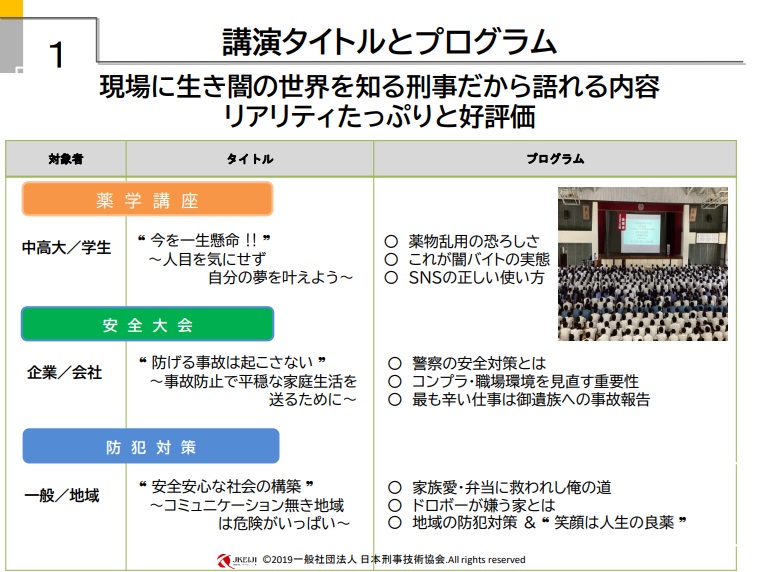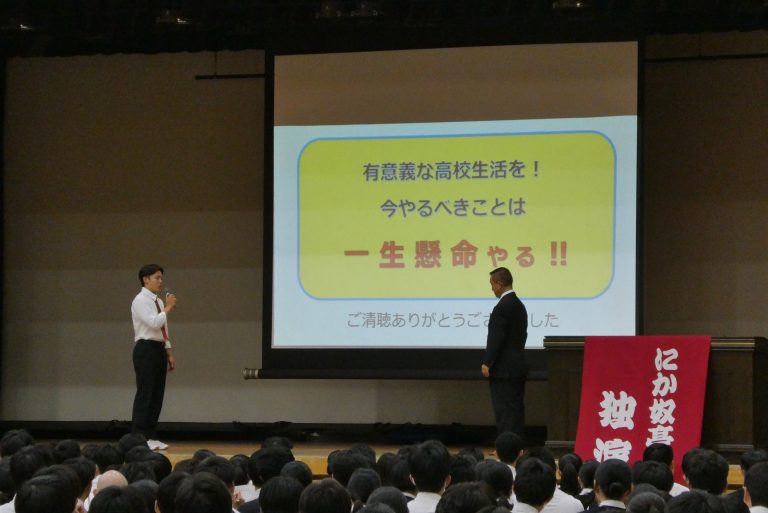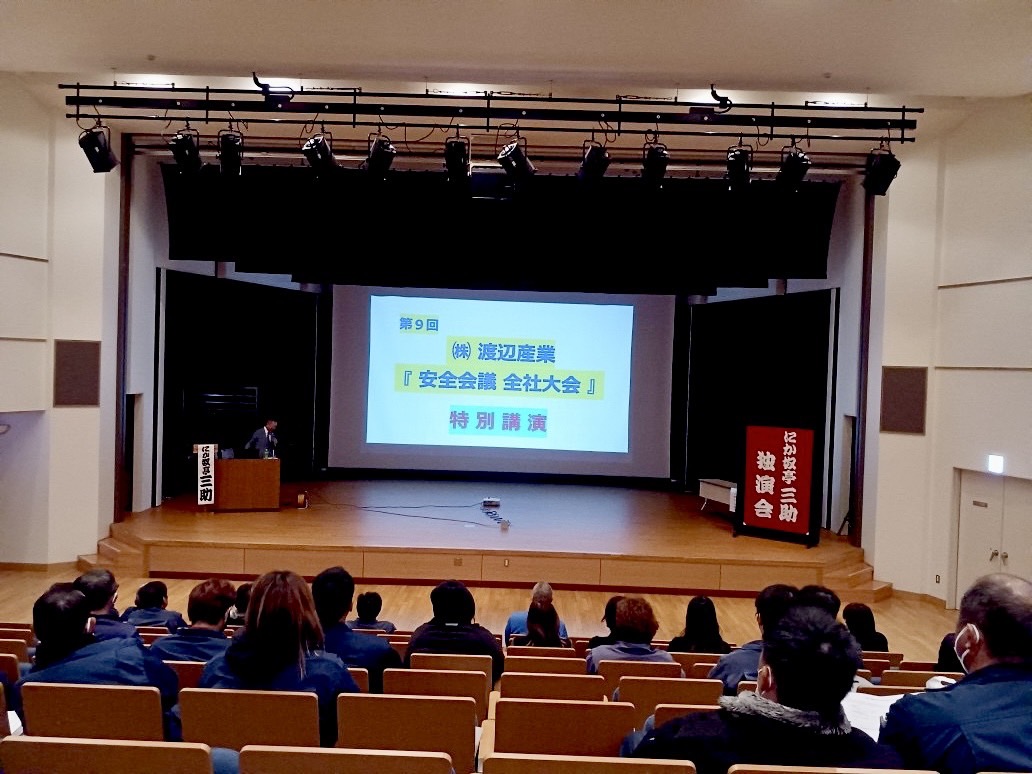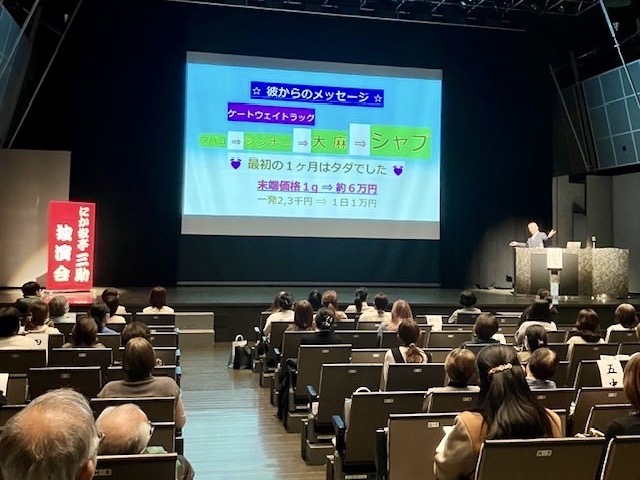Pharmacy Lecture・Safety Conference Crime・Prevention Measures: Akihito Watanabe, Lecture
1. 中学生・高校生・大学生を対象とした薬学講座 2. 企業向け講座・安全大会
3. 一般・地域を対象とした防犯対策講座

1. 中学生・高校生・大学生を対象とした薬学講座
Pharmacy Lecture for Students
Pharmacy Lecture: Hamamatsu Kaiseikan Junior & Senior High School

浜松開誠館中学校・高等学校で薬学講座を実施しました
We conducted a pharmacy lecture at Hamamatsu Kaiseikan Junior and High School.
薬学講座の感想は、学年別に下記にまとめてありますのでご覧下さい。
Please see below for the pharmacy lecture feedback, which is summarized by grade.
表題タイトルに戻る
中学生、高校生、大学生を対象とした違法薬物に関する薬学講座
中学生、高校生、大学生を対象とした違法薬物に関する薬学講座は、年齢層に応じた内容と方法で実施します。
中学生向け講座
目的:
・ 薬物の危険性についての基本的な知識を身につける。
・ 薬物乱用を拒否する態度を育成する。
・ 身近な危険から身を守る方法を学ぶ。
内容:
・ 薬物の種類と基本的な作用(シンナー、危険ドラッグなど)。
・ 薬物乱用による心身への影響(具体的な事例を含む)。
・ 誘われたときの対処法(断り方、相談窓口など)。
・ 薬物乱用防止に関する簡単な実験やロールプレイ。
方法:
・ 視覚教材(写真、映像)を多用し、分かりやすく解説する。
・ グループワークやディスカッションを取り入れ、参加型の講座にする。
・ 専門家(薬剤師、医師、警察官など)による講話。
高校生向け講座
目的:
・ 薬物の詳細な作用や依存性について理解する。
・ 薬物乱用が社会に与える影響について考える。
・ 薬物乱用防止のための知識と判断力を養う。
内容:
・ 薬物の種類と作用機序(覚醒剤、大麻、MDMAなど)。
・ 薬物依存のメカニズムと治療法。
・ 薬物乱用と犯罪、健康問題との関連性。
・ 薬物乱用に関する最新情報(インターネット上の危険性など)。
・ 薬物乱用防止のための法律や制度。
方法:
・ 講義形式だけでなく、ディベートやグループ発表を取り入れる。
・ 薬物依存症者の体験談や専門家の講演会を開催する。
・ 薬物乱用防止に関するポスターや動画の作成。
大学生向け講座
目的:
・ 薬物に関する専門的な知識を深める。
・ 薬物乱用問題に対する社会的な責任を認識する。
・ 薬物乱用防止のための啓発活動や研究活動に参加する。
内容:
・ 薬物の薬理学、毒性学、法医学に関する専門的な知識。
・ 薬物依存症の予防、治療、リハビリテーションに関する最新の研究。
・ 薬物乱用問題に関する国際的な動向。
・ 薬物乱用防止のための政策提言や啓発活動。
方法:
・ 専門家による講義や研究発表。
・ 薬物乱用問題に関するディスカッションやワークショップ。
・ 薬物乱用防止に関するボランティア活動やインターンシップ。
・ 薬物乱用に関する研究活動。
共通のポイント
・ 各年代の理解度や関心に合わせた内容にする。
・ 薬物の危険性だけでなく、正しい知識と判断力を養うことに重点を置く。
・ 相談窓口や支援機関の情報を積極的に提供する。
・ 薬物乱用は、だれにでも起こりうる問題であることを理解する。
・ 薬物乱用に関する偏見や差別をなくす。
その他
・ 薬学講座は、学校の授業や課外活動の一環として実施することができます。
・ 地域社会や関係機関と連携し、薬物乱用防止のための啓発活動を行うことも重要です。
・ 近年では、インターネットやSNSを通じて薬物に関する情報が氾濫しているため、情報リテラシー教育も重要です。
Pharmaceutical Lectures on Illegal Drugs for Junior High School, High School, and University Students
Pharmaceutical lectures on illegal drugs for junior high school, high school, and university students should be conducted with content and methods tailored to each age group.
Lectures for Junior High School Students:
Objectives:
・ To acquire basic knowledge about the dangers of drugs.
・ To cultivate an attitude of rejecting drug abuse.
・ To learn how to protect oneself from dangers in one’s immediate environment.
Content:
・ Types of drugs and their basic effects (e.g., paint thinner, dangerous drugs).
・ The effects of drug abuse on the mind and body (including specific examples).
・ How to respond when offered drugs (how to refuse, where to seek help, etc.).
・ Simple experiments and role-playing related to drug abuse prevention.
Methods:
・ Use of visual aids (photos, videos) for clear and easy-to-understand explanations.
・ Incorporation of group work and discussions to create interactive sessions.
・ Lectures by experts (pharmacists, doctors, police officers, etc.).
Lectures for High School Students:
Objectives:
・ To understand the detailed effects and addictive nature of drugs.
・ To consider the impact of drug abuse on society.
・ To develop knowledge and judgment skills for drug abuse prevention.
Content:
・ Types of drugs and their mechanisms of action (e.g., stimulants, cannabis, MDMA).
・ The mechanisms of drug addiction and treatment methods.
・ The relationship between drug abuse and crime, and health problems.
・ The latest information on drug abuse (including dangers on the internet).
・ Laws and systems for drug abuse prevention.
Methods:
・ Incorporation of debates and group presentations in addition to lectures.
・ Organization of lectures by drug addiction survivors and experts.
・ Creation of posters and videos related to drug abuse prevention
Lectures for University Students:
Objectives:
・ To deepen specialized knowledge about drugs.
・ To recognize social responsibility regarding drug abuse problems.
・ To participate in awareness campaigns and research activities for drug abuse prevention.
Content:
・ Specialized knowledge of drug pharmacology, toxicology, and forensic medicine.
・ The latest research on the prevention, treatment, and rehabilitation of drug addiction.
・ International trends in drug abuse problems.
・ Policy recommendations and awareness campaigns for drug abuse prevention.
Methods:
・ Lectures and research presentations by experts.
・ Discussions and workshops on drug abuse problems.
・ Volunteer activities and internships related to drug abuse prevention.
・ Research activities on drug abuse.
Common Points:
・ Tailor content to the understanding and interests of each age group.
・ Focus on developing correct knowledge and judgment skills, not just the dangers of drugs.
・ Actively provide information on consultation services and support organizations.
・ Understand that drug abuse is a problem that can happen to anyone.
・ Eliminate prejudice and discrimination related to drug abuse.
Other:
・ Pharmaceutical lectures can be conducted as part of school classes or extracurricular activities.
・ Collaboration with local communities and related organizations is important for conducting awareness campaigns for drug abuse prevention.
・ In recent years, information about drugs has been flooding the internet and social media, so information literacy education is also important.
Please use this information to conduct effective pharmaceutical lectures tailored to each age group.
違法薬物の種類講座
違法薬物は、法律で規制されている薬物のことで、種類によって人体に及ぼす影響や依存性が異なります。主な違法薬物の種類と特徴は以下の通りです。
1. 覚醒剤
・ 中枢神経を興奮させ、高揚感、多幸感、集中力向上などの効果をもたらす。
・ 強い依存性があり、乱用すると幻覚、妄想、錯乱などの精神症状が現れることがある。
・ 覚醒剤取締法で規制されています。
2. 大麻
・ 精神作用があり、リラックス効果、多幸感、知覚の変化などを引き起こす。
・ 長期使用により、精神疾患のリスクを高める可能性がある。
・ 大麻取締法で規制されています。
3. コカイン
・ 強力な興奮作用があり、高揚感、快感、集中力向上などの効果をもたらす。
・ 強い依存性があり、乱用すると心臓発作、呼吸困難、精神錯乱などを引き起こすことがある。
・ 麻薬及び向精神薬取締法で規制されています。
4. MDMA(合成麻薬)
・ 幻覚作用と興奮作用があり、多幸感、高揚感、共感性の向上などを引き起こす。
・ 乱用すると、脱水症状、高体温、精神錯乱などを引き起こすことがある。
・ 麻薬及び向精神薬取締法で規制されています。
5. ヘロイン
・ 強力な鎮痛作用と陶酔作用があり、快感、多幸感などを引き起こす。
・ 強い依存性があり、過剰摂取すると呼吸困難で死亡することがある。
・ 麻薬及び向精神薬取締法で規制されています。
6. LSD
・ 強力な幻覚作用があり、視覚、聴覚、時間感覚などに大きな変化を引き起こす。
・ 精神に与える影響が大きく、フラッシュバック(幻覚の再燃)などの精神症状が現れることがある。
・ 麻薬及び向精神薬取締法で規制されています。
7. 危険ドラッグ
・ 法律で規制されている薬物の成分をわずかに変えたもので、様々な形態で販売されている。
・ 成分が不明なものが多く、健康被害のリスクが高い。
・ 医薬品医療機器等法で規制されています。
8. 向精神薬
・ 中枢神経に作用し、精神機能に影響を及ぼす薬物の総称。
・ 医師の処方箋が必要な医薬品も含まれるが、乱用すると依存性や健康被害を引き起こすことがある。
・ 麻薬及び向精神薬取締法で規制されています。
9. 有機溶剤(シンナー等)
・ 中枢神経を抑制し、酩酊感、幻覚などを引き起こす。
・ 乱用すると、呼吸困難、意識障害、臓器障害などを引き起こすことがある。
・ 毒物及び劇物取締法で規制されています。
これらの違法薬物は、一度の使用でも健康に深刻な影響を与える可能性があります。絶対に手を出さないようにしましょう。
Categories of Illegal Drugs and Substances
Illegal drugs are substances regulated by law, and their effects on the human body and potential for addiction vary depending on the type. Here are the main types of illegal drugs and their characteristics:
1. Stimulants (e.g., Methamphetamine)
・ Stimulate the central nervous system, producing effects such as euphoria, heightened mood, and increased concentration.
・ Highly addictive, and abuse can lead to mental health symptoms like hallucinations, delusions, and confusion.
・ Regulated under the Stimulants Control Act.
2. Cannabis (Marijuana)
・ Has psychoactive effects, inducing relaxation, euphoria, and altered perceptions.
・ Long-term use may increase the risk of mental health disorders.
・ Regulated under the Cannabis Control Act.
3. Cocaine
・ A powerful stimulant that produces euphoria, pleasure, and increased concentration.
・ Highly addictive, and abuse can lead to heart attacks, respiratory problems, and mental confusion.
・ Regulated under the Narcotics and Psychotropic Drugs Control Act.
4. MDMA (Ecstasy)
・ Has hallucinogenic and stimulant effects, inducing euphoria, heightened mood, and increased feelings of empathy.
・ Abuse can lead to dehydration, hyperthermia, and mental confusion.
・ Regulated under the Narcotics and Psychotropic Drugs Control Act.
5. Heroin
・ A powerful painkiller and narcotic that produces pleasure and euphoria.
・ Highly addictive, and overdose can lead to respiratory depression and death.
・ Regulated under the Narcotics and Psychotropic Drugs Control Act.
6. LSD (Lysergic Acid Diethylamide)
・ A potent hallucinogen that causes significant alterations in visual, auditory, and time perception.
・ Has a significant impact on mental state, and can lead to mental health symptoms such as flashbacks.
・ Regulated under the Narcotics and Psychotropic Drugs Control Act.
7. Dangerous Drugs (Designer Drugs)
・ Substances with slightly altered chemical compositions of legally regulated drugs, sold in various forms.
・ Often have unknown ingredients, posing a high risk of health hazards.
・ Regulated under the Pharmaceuticals and Medical Devices Act.
8. Psychotropic Drugs
・ A general term for substances that affect the central nervous system and influence mental functions.
・ Includes prescription medications, but abuse can lead to addiction and health problems.
・ Regulated under the Narcotics and Psychotropic Drugs Control Act.
9. Organic Solvents (e.g., Paint Thinner)
・ Depress the central nervous system, inducing intoxication and hallucinations.
・ Abuse can lead to respiratory problems, loss of consciousness, and organ damage.
・ Regulated under the Poisonous and Deleterious Substances Control Act.
These illegal drugs can have serious health consequences, even from a single use. It is crucial to avoid them entirely.
合法ドラックという名の違法薬物 合成薬物の危険性
「合法ドラッグ」という言葉は誤解を招きやすく、実際には「危険ドラッグ」と呼ばれるものが該当します。これらは、法律で規制されている薬物の成分をわずかに変化させたもので、あたかも合法であるかのように販売されていますが、非常に危険な物質です。
1・危険ドラッグの主な危険性:
成分が不明確:
・ 危険ドラッグは、成分が不明確なものが多く、何が含まれているか、どのような作用があるか、全く分からないことがあります。
・ 同じ製品名でも、製造ロットによって成分が異なったり、有害な物質が混入していたりすることもあります。
健康被害のリスクが高い:
・ 成分が不明確なため、どのような健康被害が起こるか予測できません。
・ 急性中毒、意識障害、呼吸困難、心臓発作、精神錯乱、幻覚、妄想など、生命に関わる重篤な健康被害を引き起こす可能性があります。
・ 一度の使用でも、死亡につながるケースがあります。
依存性:
・ 危険ドラッグには、強い依存性を持つ物質が含まれていることがあります。
・ 一度使用すると、やめたくてもやめられなくなり、心身に深刻なダメージを与える可能性があります。
法規制:
・ 危険ドラッグは、法律で規制されている薬物の成分をわずかに変化させたものであるため、次々と新しい物質が現れます。
・ 規制が追いつかず、合法であるかのように販売されている場合がありますが、これらは非常に危険です。
・ 「合法」と謳っていても、実際は違法なドラッグであるケースがほとんどです。
2・危険ドラッグに関する重要な注意点:
・ 「合法ハーブ」「合法アロマ」「バスソルト」などの名称で販売されていても、決して安全ではありません。
・ 危険ドラッグは、麻薬や覚醒剤と同様に、心身に深刻な影響を与える可能性があります。
・ 危険ドラッグに関する情報は、インターネットやSNSなどで誤った情報が拡散されていることがあります。信頼できる情報源から情報を得るようにしましょう。
・ もし、危険ドラッグの使用で体調が悪くなった場合は、すぐに医療機関を受診してください。
危険ドラッグは、あなたの健康と人生を破壊する可能性があります。絶対に手を出さないようにしましょう。
Illegal Drugs Sold as "Legal": There's No Legality
The term “legal drugs” is misleading, and in reality, it refers to what are called ‘dangerous drugs. These are substances with slightly altered chemical compositions of legally regulated drugs, sold as if they were legal, but they are extremely dangerous substances.
1.Main dangers of dangerous drugs:
Unclear ingredients:
・ Dangerous drugs often have unclear ingredients, and it may be completely unknown what they contain or what effects they have.
・ Even with the same product name, the ingredients may vary depending on the production lot, or harmful substances may be mixed in.
High risk of health hazards:
・ Because the ingredients are unclear, it is impossible to predict what kind of health damage may occur.
・ They can cause serious health hazards that threaten life, such as acute poisoning, loss of consciousness, respiratory problems, heart attacks, mental confusion, hallucinations, and delusions.
・ Even a single use can lead to death.
Addiction:
・ Dangerous drugs may contain substances with strong addictive properties.
・ Once used, it can become impossible to quit, causing serious damage to the mind and body.
Legal regulations:
・ Because dangerous drugs are substances with slightly altered chemical compositions of legally regulated drugs, new substances appear one after another.
・ Regulations cannot keep up, and they may be sold as if they were legal, but these are extremely dangerous.
・ Although they may be advertised as “legal,” in reality, most cases are illegal drugs.
Important points to note about dangerous drugs:
・ Even if they are sold under names such as “legal herbs,” “legal aromas,” or “bath salts,” they are by no means safe.
・ Dangerous drugs can have serious effects on the mind and body, similar to narcotics and stimulants.
・ False information about dangerous drugs may be spread on the internet and social media. Be sure to obtain information from reliable sources.
・ If you feel unwell from using dangerous drugs, seek medical attention immediately.
Dangerous drugs can destroy your health and life. Never get involved with them.”
違法薬物依存症の実態
違法薬物依存症は、単なる意志の弱さではなく、脳の機能が変化してしまう病気です。ここでは、その実態について詳しく解説します。
1. 依存のメカニズム
・ 脳への影響: 違法薬物は、脳の快楽中枢を刺激し、ドーパミンという神経伝達物質を過剰に放出させます。この快感が忘れられず、薬物を繰り返し求めるようになります。
・ 耐性と離脱症状: 薬物を繰り返すうちに、同じ量では満足できなくなり(耐性)、使用をやめると不快な症状(離脱症状)が現れるようになります。これにより、薬物から抜け出せなくなります。
2. 依存の実態
・ 精神的依存: 薬物への強い欲求や渇望が生じ、薬物のことばかり考えるようになります。
・ 身体的依存: 薬物が体からなくなると、震え、発汗、吐き気、不眠などの離脱症状が現れます。
・ 社会的依存: 薬物使用が原因で、仕事や家庭を失い、人間関係が崩壊することがあります。
3. 依存しやすい薬物
・ 覚醒剤: 強い精神依存と身体依存を引き起こします。
・ 危険ドラッグ: 幻覚や妄想を引き起こし、精神依存を形成しやすいです。
・ 大麻: 精神依存を形成し、長期使用で精神疾患のリスクを高めます。
・ コカイン、ヘロイン: 強い精神依存と身体依存を引き起こします。
4. 依存症の進行
・ 初期段階: 快感を求めて薬物を使用し始めます。
・ 中期段階: 耐性や離脱症状が現れ、薬物使用が習慣化します。
・ 末期段階: 薬物なしでは生活できなくなり、心身ともにボロボロになります。
5. 依存症からの回復
・ 専門機関への相談: 医療機関や依存症専門の相談窓口に相談しましょう。
・ 治療: 薬物療法や精神療法、リハビリテーションなど、専門的な治療が必要です。
・ 自助グループ: 同じ依存症に苦しむ仲間との交流が、回復への大きな支えになります。
・ 周囲のサポート: 家族や友人の理解と協力が不可欠です。
6. 薬物依存に関する相談窓口
・ 各都道府県の精神保健福祉センター
・ 薬物依存者回復支援施設
・ 精神科、心療内科
違法薬物依存症は、誰にでも起こりうる病気です。一人で悩まず、専門機関に相談し、適切な治療を受けることが大切です。
The Reality of Illegal Drug Addiction
Illegal drug addiction is not just a weakness of will, but a disease that changes brain function. Here, we will explain the actual situation in detail.
1. Mechanism of addiction
・ Effects on the brain: Illegal drugs stimulate the brain’s pleasure center and cause an excessive release of the neurotransmitter dopamine. This pleasure is unforgettable, and the person repeatedly seeks the drug.
・ Tolerance and withdrawal symptoms: As drug use is repeated, the same amount no longer satisfies the user (tolerance), and unpleasant symptoms (withdrawal symptoms) appear when use is stopped. This makes it impossible to break free from drugs.
2. The reality of addiction
・ Psychological dependence: Strong desires and cravings for drugs arise, and the person thinks only about drugs.
・ Physical dependence: When the drug is gone from the body, withdrawal symptoms such as tremors, sweating, nausea, and insomnia appear.
・ Social dependence: Drug use can cause the loss of work and family, and the breakdown of relationships.
3. Drugs that are prone to addiction
・ Stimulants: Cause strong psychological and physical dependence.
・ Dangerous drugs: Cause hallucinations and delusions, and are prone to forming psychological dependence.
・ Cannabis: Forms psychological dependence and increases the risk of mental illness with long-term use.
・ Cocaine, heroin: Cause strong psychological and physical dependence.
4. Progression of addiction
・ Initial stage: Start using drugs for pleasure.
・ Middle stage: Tolerance and withdrawal symptoms appear, and drug use becomes habitual.
・ Final stage: Life becomes impossible without drugs, and the mind and body become tattered.
5. Recovery from addiction
・ Consultation with a specialized organization: Consult with a medical institution or a specialized addiction consultation service.
・ Treatment: Specialized treatment such as pharmacotherapy, psychotherapy, and rehabilitation is required.
・ Self-help groups: Interaction with fellow sufferers of the same addiction is a great support for recovery.
・ Support from those around you: Understanding and cooperation from family and friends is essential.
6. Consultation services for drug addiction
・ Prefectural and municipal mental health and welfare centers
・ Drug addiction recovery support facilities
・ Psychiatry, psychosomatic medicine clinics
Illegal drug addiction is a disease that can happen to anyone. Do not suffer alone, consult with a specialized organization, and receive appropriate treatment.
違法薬物と反社会的勢力との繋がり
違法薬物と反社会的勢力との繋がりは、非常に深く、複雑です。以下に、その関係性について詳しく説明します。
1. 資金源としての関係
・ 違法薬物の密売は、反社会的勢力にとって重要な資金源の一つです。特に、覚醒剤やコカインなどの高価な薬物は、大きな利益を生み出します。
・ これらの資金は、組織の維持、武器の購入、他の犯罪活動などに使われます。
2. 組織の維持・拡大
・ 反社会的勢力は、構成員に違法薬物を使用させることで、組織への依存性を高め、統制を維持しようとします。
・ また、違法薬物の密売ネットワークは、組織の拡大にも利用されます。
3. 犯罪の温床
・ 違法薬物の使用は、幻覚や妄想、暴力性の亢進などを引き起こし、使用者を犯罪に走らせる可能性があります。
・ また、反社会的勢力は、違法薬物の使用者を犯罪に利用することもあります。例えば、運び屋や末端の売人として利用するケースがあります。
4. 国際的な繋がり
・ 違法薬物の密輸は、国際的な犯罪組織と反社会的勢力との連携を強める要因となります。
・ これらの組織は、国境を越えて協力し、薬物の生産、輸送、販売を行っています。
具体的な影響
・ 違法薬物の蔓延は、社会全体の安全を脅かし、治安の悪化につながります。
・ 薬物依存による健康被害や精神疾患は、個人の生活を破壊するだけでなく、医療費の増大など、社会的な負担も増加させます。
・ 違法薬物の密売によって得られた資金は、他の犯罪活動にも使われ、社会全体の安全を脅かします。
対策
・ 警察による取り締まりの強化
・ 国際的な連携による密輸対策
・ 薬物乱用防止のための啓発活動
・ 薬物依存者の治療・更生支援
違法薬物と反社会的勢力の繋がりを断ち切るためには、これらの対策を総合的に進めることが重要です。
The Connection Between Illegal Drugs and Antisocial Forces
The connection between illegal drugs and antisocial forces is very deep and complex. The relationship is explained in detail below:
1. Relationship as a source of funds
・ The illegal drug trade is an important source of funds for antisocial forces. In particular, expensive drugs such as stimulants and cocaine generate large profits.
・ These funds are used to maintain organizations, purchase weapons, and other criminal activities.
2. Maintaining and expanding organizations
・ Antisocial forces try to maintain control by making members use illegal drugs, thereby increasing their dependence on the organization.
・ In addition, illegal drug trafficking networks are also used to expand organizations.
3. A hotbed of crime
・ The use of illegal drugs can cause hallucinations, delusions, and increased violence, which can lead users to commit crimes.
・ In addition, antisocial forces may use illegal drug users for crimes. For example, some may be used as carriers or low-level dealers.
4. International connections
・ Illegal drug smuggling is a factor that strengthens cooperation between international criminal organizations and antisocial forces.
・ These organizations cooperate across borders to produce, transport, and sell drugs.
Specific effects
・ The spread of illegal drugs threatens the safety of society as a whole and leads to deterioration of public safety.
・ Health damage and mental illness due to drug addiction not only destroy individual lives, but also increase social burdens such as increased medical costs.
・ Funds obtained through illegal drug trafficking are used for other criminal activities, threatening the safety of society as a whole.
Measures
・ Strengthening police crackdowns
・ International cooperation to counter smuggling
・ Educational activities to prevent drug abuse
・ Treatment and rehabilitation support for drug addicts
In order to break the connection between illegal drugs and antisocial forces, it is important to comprehensively promote these measures.


薬学講座 渡邉晃人 講師
Pharmacy Lecture: Akihito Watanabe, Lecture



薬学講座を終えて 生徒の感想
Student Impressions After a Pharmacy Lecture
表題タイトルに戻る
薬学講座を終えて
令和6年11月12日(火)、元刑事で、現在は落語家「にか奴亭三助」として活躍している渡邉晃人先生をお招きし、薬学講座を実施しました。先生からのメッセージをどう感じたのか、皆さんの感想を紹介させていただきます。
中1
僕は渡邉先生の話を聞いて、違法ドラッグの怖さについて再認識しました。中でもフラッシュバック、ゲートウェイドラッグについて初めて知りました。そして最近よく聞く闇バイトについても知ることができ実行犯の存在は単なる道具だということについて知り、とても怖いと思いました。僕は誘われても必ず強い意志で断ります。
中2
元刑事で危ない事件に関わり、犯罪をした人を捕まえていた渡邉先生の話を聞いて一番大切なのは「人情」なのだと気づくことができました。最近はSNSを利用した闇バイトが広まっているそうなので、しっかりと間違った道に行かないように気をつけ、もし友達に何かあったら助けられる人になりたいと思いました。誰からも信頼され、恩返ししてもらえるよう過ごしていきたいです。
中3
私は今回の薬学講座を受けて、薬物乱用や闇バイトの危険性や知識だけでなく、これからの人生観についても学ぶことができました。特に印象に残っているのは、「ありのままの自分」「自分が信じた道を行く」という言葉です。これからの人生の中で、たくさんの考え方や選択する場面に出会うと思います。そのときにどの道に行くのか、自分の意志・意見をしっかり持ち、信じて進んでいこうと思います。薬物においても流されない強い意志が大切だと学びました。ありのままの自分、自分の強い意志を持ち、生活していきたいと思います。
高1
今回の講座では、薬物や危険ドラッグ、最近、話題になっている闇バイトの恐ろしさだけでなく、これからを生きていく上で大切な考え方や一生懸命やることで得られることなど多くのことを学ぶことができた。命は1つだが、夢はいくらでも見ることができる。だからドラッグや闇バイトによって、たった1つの大切な命を無駄にするのではなく、色々な夢を叶えるための行動をしていこうと感じた。実力を120%発揮するためには「克己心」「自分に打ち勝つ強い力」が必要だと言っていた。ありのままの自分で人目を気にせず、自分の信じた道を一生懸命突き進んで生きていこうと思う。
高2
僕は、渡邉先生と同じで「1人でアメリカに行き、コミュニケーションをとりたい」という夢を持っています。しかし、そんな夢があっても薬物を乱用してしまえば叶うことはないのだと思いました。夢だけでなく、全てを失ってしまうことになり、とても悲しいことだと思いました。自分は夢を叶えるために努力をし、薬物乱用とは無縁の人生を送ります。
高3
私は、今回の薬学講座を経て、薬物の恐ろしさはもちろん、その道に踏み入れるきっかけを作らないような友人作りや断る勇気、強い意志など自分の人生をより楽しく生きるために必要なことを学ぶことができました。自分に打ち勝つ強い心を持つことや挨拶の面など私もスポーツをする上で大切なことを身につけていきたいと思いました。真っ当な人生を歩み、薬物など外れた道に行かないように自分の信じた道を歩みたいです。
After the Pharmacy Lecture
On Tuesday, November 12, 2024, we invited Mr. Akihto Watanabe, a former detective and now a rakugo performer known as “Nikayakkotei Sansuke,” to give a pharmacy lecture. We would like to share everyone’s thoughts on Mr. Watanabe’s message.
Junior High 1
After listening to Mr. Watanabe’s talk, I reaffirmed the dangers of illegal drugs. I learned about flashbacks and gateway drugs for the first time. I also learned about the dark side jobs that I often hear about these days, and I was very scared to learn that the perpetrators are just tools. I will always refuse with a strong will, even if I am tempted.
Junior High 2
After listening to Mr. Watanabe, who was a former detective involved in dangerous cases and arrested criminals, I realized that the most important thing is “humanity.” I want to be a person who can help my friends if they are in trouble, and I want to be trusted by everyone and live my life so that I can repay them.
Junior High 3
Through this pharmacy lecture, I was able to learn not only about the dangers and knowledge of drug abuse and dark side jobs, but also about my outlook on life. I was especially impressed by the words “be yourself” and “follow the path you believe in.” I think I will encounter many situations in my life where I have to think and choose. At such times, I will have a strong will and opinion, and I will believe in myself and move forward. I also learned that a strong will not to be swayed by drugs is important. I want to live my life with my true self and my strong will.
High School 1
In this lecture, I learned not only about the dangers of drugs and dangerous drugs, and the dark side jobs that have been in the news recently, but also about many things such as important ways of thinking and the things that can be gained by doing one’s best. Life is one, but dreams can be seen as many as you want. That’s why I felt that instead of wasting a precious life with drugs or dark side jobs, I should take action to make my dreams come true. He said that in order to exert 120% of your ability, you need “self-control” and “the strong power to overcome yourself.” I will live my life going straight on the path I believe in, without worrying about what other people think, with my true self.
High School 2
Like Mr. Watanabe, I have a dream of “going to America alone and wanting to communicate.” However, I realized that even if I have such a dream, it will not come true if I abuse drugs. I thought it would be very sad to lose not only my dream but also everything. I will strive to make my dream come true and live a life free from drug abuse.
High School 3
Through this pharmacy lecture, I was able to learn not only about the dangers of drugs, but also about the importance of making friends who do not create opportunities to get into drugs, the courage to refuse, and a strong will to live a more fulfilling life. I also want to acquire the important things that I need to do in sports, such as having a strong mind to overcome myself and greeting people. I want to live a straight life and walk the path I believe in so that I do not go astray into drugs.
2. 企業向け講座・安全大会
『安全大会』 防げる事故は起こさない
“Safety Rally” Preventable accidents don’t happen.
警察での取組方を紹介しますので、事故防止にお役立て下さい。
会社の安全管理と家族の幸せのために!
We will introduce the police’s initiatives, so please use them to prevent accidents.
For the safety management of the company and the happiness of the family!

安全大会 株式会社 渡辺産業 物流会社 交通事故防止
Safety Conference: Watanabe Sangyo Logistics Co., Ltd. Traffic Accident Prevention

講演講師 渡邊 晃人
Lecture: Akihito Watanabe
表題タイトルに戻る
企業の安全大会について
安全大会は、企業が従業員の安全意識を高め、労働災害の防止を目的として開催する集会です。
目的:
・労働災害の防止
・安全意識の向上
・安全に関する知識の共有
・法令遵守の徹底
内容:
・安全講話:専門家や経験者による講演
・安全表彰:安全活動に貢献した従業員の表彰
・安全教育:具体的な事例を用いた教育や訓練
・安全標語・スローガンの発表
・安全に関する情報共有
開催時期:
多くの企業で、厚生労働省が定める「全国安全週間」(毎年7月1日~7日)の前後に開催されます。
対象者:
・原則として、全従業員が対象ですが、業種や企業の規模によって異なります。
・建設業などでは、取引先や関係会社の方も参加する場合があります。
その他:
近年では、新型コロナウイルス感染症対策として、オンラインでの開催や、参加人数を制限しての開催も増えています。
安全大会の開催は、労働安全衛生法で義務付けられているわけではありませんが、多くの企業が自主的に実施しています。
より詳しい情報を知りたい場合は、以下の情報も参考になるかと思います。
・厚生労働省:労働安全衛生法
・中央労働災害防止協会
Corporate Safety Conference Lecture
A safety conference is a gathering held by companies to raise employee safety awareness and prevent occupational accidents.
Purpose:
Prevention of occupational accidents
Improvement of safety awareness
Sharing of safety-related knowledge
Thorough compliance with laws and regulations
Contents:
Safety lectures: Lectures by experts and experienced individuals
Safety awards: Recognition of employees who have contributed to safety activities
Safety education: Education and training using specific examples
Announcement of safety slogans
Sharing of safety-related information
Timing:
Many companies hold these conferences around the time of “National Safety Week” (July 1-7 every year), as designated by the Ministry of Health, Labour and Welfare.
Target Audience:
In principle, all employees are targeted, but this varies depending on the industry and company size.
In industries such as construction, business partners and related companies may also participate.
Other:
In recent years, due to measures against COVID-19, there has been an increase in online conferences and conferences with limited participation.
Holding a safety conference is not mandated by the Industrial Safety and Health Act, but many companies implement it voluntarily.
The following information may be helpful if you would like to know more details.
Ministry of Health, Labour and Welfare: Industrial Safety and Health Act
Japan Industrial Safety and Health Association
表題タイトルに戻る
実践的企業コンプライアンス問題と対策
企業に求められるコンプライアンスとは、単なる「法令遵守」に留まらず、倫理や道徳、社会規範といった幅広い要素を含みます。企業は、公正かつ公平な業務遂行を通じて、社会からの信頼を獲得する必要があります。本稿では、企業におけるコンプライアンス体制の構築、違反事例とそのリスク、そして予防策について解説します。
1. 企業コンプライアンス問題の具体例
法令違反:
・ 労働基準法違反(長時間労働、不払い残業など)
・ 個人情報保護法違反(情報漏洩、不正利用など)
・ 独占禁止法違反(カルテル、談合など)
・ 不正会計、粉飾決算
倫理違反:
・ ハラスメント(パワーハラスメント、セクシュアルハラスメントなど)
・ 贈収賄、不正な利益供与
・ 環境問題(環境汚染、不法投棄など)
・ 品質偽装、データ改ざん
その他:
・ 情報セキュリティ問題(サイバー攻撃、情報漏洩など)
・ サプライチェーンにおける人権問題
2. 企業コンプライアンス対策のポイント
経営トップのコミットメント:
・ 経営トップがコンプライアンスの重要性を認識し、率先垂範することが不可欠です。
・ コンプライアンス方針を明確に示し、組織全体に浸透させます。
・ コンプライアンス体制の構築:
・ コンプライアンス担当部署や責任者を設置し、役割と責任を明確にします。
・ 内部通報制度(ホットライン)を整備し、早期の問題発見と解決を図ります。
・ 定期的なリスク評価を行い、潜在的なリスクを把握します。
コンプライアンス教育・研修:
・ 全従業員を対象に、定期的なコンプライアンス研修を実施します。
・ 法令や企業倫理に関する知識だけでなく、具体的な事例を用いた実践的な研修を行います。
・ eラーニングなどの活用も有効です。
内部監査・モニタリング:
・ 定期的な内部監査を実施し、コンプライアンス体制の有効性を評価します。
・ モニタリングシステムを導入し、不正行為の早期発見に努めます。
違反時の対応:
・ 違反が発生した場合、迅速かつ適切な対応を行います。
・ 原因究明と再発防止策の策定、関係者への処分などを行います。
・ 外部への情報開示も適切に行います。
企業文化の醸成:
・ コンプライアンスを重視する企業文化を醸成します。
・ 従業員が倫理的な判断を下せるよう、教育や啓発活動を行います。
3. 実践的な対策
リスクアセスメントの実施:
・ 事業内容や組織体制に応じて、重点的に取り組むべきコンプライアンスリスクを特定します。
・ リスクの発生頻度や影響度を評価し、優先順位をつけます。
行動規範・ガイドラインの策定:
・ 具体的な事例を盛り込んだ行動規範やガイドラインを作成し、従業員の行動指針とします。
・ 定期的に見直し、最新の法令や社会情勢に合わせて改訂します。
サプライチェーン・マネジメント:
・ 取引先のコンプライアンス状況を把握し、問題がある場合は改善を求めます。
・ サプライチェーン全体で人権尊重や環境保護に取り組む体制を構築します。
テクノロジーの活用:
・ コンプライアンス管理システムを導入し、効率的なリスク管理やモニタリングを行います。
・ AIを活用した不正検知システムや、データ分析によるリスク予測も有効です。
4. 企業コンプライアンスの重要性
企業の信頼性向上:
・コンプライアンスを徹底することで、顧客、取引先、投資家などからの信頼を得ることができます。
リスク回避:
法令違反や倫理違反による訴訟、制裁金、風評被害などのリスクを回避できます。
持続的な成長:
・ コンプライアンスを重視する企業は、社会からの評価も高く、持続的な成長が期待できます。
企業コンプライアンスは、常に変化する社会情勢や法令に対応していく必要があります。継続的な取り組みと改善を通じて、企業価値の向上を目指しましょう。
・ コンプライアンスを重視する企業は、社会からの評価も高く、持続的な成長が期待できます。
企業コンプライアンスは、常に変化する社会情勢や法令に対応していく必要があります。継続的な取り組みと改善を通じて、企業価値の向上を目指しましょう。
Practical Corporate Compliance Issues and Countermeasures
Corporate compliance is not limited to mere “legal compliance” but includes a wide range of elements such as ethics, morals, and social norms. Companies need to gain trust from society through fair and equitable business execution. This article explains the establishment of a corporate compliance system, violation cases and their risks, and preventive measures.
1. Specific Examples of Corporate Compliance Issues
Legal Violations:
・ Violations of labor standards laws (e.g., excessive working hours, unpaid overtime)
・ Violations of personal information protection laws (e.g., information leaks, unauthorized use)
・ Violations of antitrust laws (e.g., cartels, bid-rigging)
・ Accounting fraud, financial statement fraud
Ethical Violations:
・ Harassment (e.g., power harassment, sexual harassment)
・ Bribery, improper provision of benefits
・ Environmental issues (e.g., environmental pollution, illegal dumping)
・ Quality falsification, data tampering
Other Issues:
・ Information security problems (e.g., cyberattacks, information leaks)
・ Human rights issues in the supply chain
2. Key Points for Corporate Compliance Measures
Commitment from Top Management:
・ It is essential for top management to recognize the importance of compliance and lead by example.
・ Clearly define compliance policies and ensure they permeate the entire organization.
Establishment of a Compliance System:
・ Establish compliance departments and appoint responsible personnel, clarifying roles and responsibilities.
・ Implement an internal reporting system (hotline) to facilitate early detection and resolution of problems.
・ Conduct regular risk assessments to identify potential risks.
Compliance Education and Training:
・ Conduct regular compliance training for all employees.
・ Provide practical training using specific examples, in addition to knowledge of laws and corporate ethics.
・ Utilizing e-learning and other methods is also effective.
Internal Audits and Monitoring:
・ Conduct regular internal audits to assess the effectiveness of the compliance system.
・ Implement a monitoring system to strive for early detection of fraudulent activities.
Response to Violations:
・ Take swift and appropriate action when violations occur.
・ Conduct investigations to determine the cause, formulate measures to prevent recurrence, and take disciplinary action against those involved.
・ Disclose information to external parties appropriately.
Fostering a Corporate Culture:
・ Foster a corporate culture that emphasizes compliance.
・ Provide education and awareness activities to enable employees to make ethical decisions.
3. Practical Measures
Implementation of Risk Assessments:
・ Identify compliance risks that should be prioritized according to business activities and organizational structure.
・ Assess the frequency and impact of risks and prioritize them.
Formulation of Codes of Conduct and Guidelines:
・ Create codes of conduct and guidelines that include specific examples to serve as behavioral guidelines for employees.
・ Review them regularly and revise them in accordance with the latest laws and social conditions.
Supply Chain Management:
・ Understand the compliance status of business partners and request improvements if problems are found.
・ Build a system to address human rights and environmental protection throughout the supply chain.
Utilization of Technology:
・ Introduce compliance management systems to efficiently manage risks and conduct monitoring.
・ Utilizing AI-powered fraud detection systems and data analysis for risk prediction is also effective.
4. Importance of Corporate Compliance
Enhancing Corporate Credibility:
Thorough compliance can earn trust from customers, business partners, investors, and others.
Risk Avoidance:
Risks such as lawsuits, fines, and reputational damage due to legal and ethical violations can be avoided.
Sustainable Growth:
Companies that emphasize compliance are highly regarded by society and can expect sustainable growth.
Corporate compliance requires continuous adaptation to ever-changing social conditions and laws. Aim to enhance corporate value through ongoing efforts and improvements.
企業安全大会の講演
安全大会は、企業が従業員の安全意識を高め、労働災害の防止を目的として開催する集会です。
目的:
- 労働災害の防止
- 安全意識の向上
- 安全に関する知識の共有
- 法令遵守の徹底
内容:
- 安全講話:専門家や経験者による講演
- 安全表彰:安全活動に貢献した従業員の表彰
- 安全教育:具体的な事例を用いた教育や訓練
- 安全標語・スローガンの発表
- 安全に関する情報共有
開催時期:
多くの企業で、厚生労働省が定める「全国安全週間」(毎年7月1日~7日)の前後に開催されます。
対象者:
- 原則として、全従業員が対象ですが、業種や企業の規模によって異なります。
- 建設業などでは、取引先や関係会社の方も参加する場合があります。
その他:
- 近年では、新型コロナウイルス感染症対策として、オンラインでの開催や、参加人数を制限しての開催も増えています。
- 安全大会の開催は、労働安全衛生法で義務付けられているわけではありませんが、多くの企業が自主的に実施しています。
より詳しい情報を知りたい場合は、以下の情報も参考になるかと思います。
- 厚生労働省:労働安全衛生法
- 中央労働災害防止協会
Corporate Safety Conference Lecture
A safety conference is a gathering held by companies to raise employee safety awareness and prevent occupational accidents.
Purpose:
Prevention of occupational accidents
Improvement of safety awareness
Sharing of safety-related knowledge
Thorough compliance with laws and regulations
Contents:
Safety lectures: Lectures by experts and experienced individuals
Safety awards: Recognition of employees who have contributed to safety activities
Safety education: Education and training using specific examples
Announcement of safety slogans
Sharing of safety-related information
Timing:
Many companies hold these conferences around the time of “National Safety Week” (July 1-7 every year), as designated by the Ministry of Health, Labour and Welfare.
Target Audience:
In principle, all employees are targeted, but this varies depending on the industry and company size.
In industries such as construction, business partners and related companies may also participate.
Other:
In recent years, due to measures against COVID-19, there has been an increase in online conferences and conferences with limited participation.
Holding a safety conference is not mandated by the Industrial Safety and Health Act, but many companies implement it voluntarily.
The following information may be helpful if you would like to know more details.
Ministry of Health, Labour and Welfare: Industrial Safety and Health Act
Japan Industrial Safety and Health Association
市川市少年補導員連絡協議会 第3回定例会 公演 講演講師 渡邉 晃人




Ichikawa City Juvenile Guidance Officer Liaison Council, 3rd Regular Meeting, Public Performance, Lecture by Akihito Watanabe
3. 一般・地域を対象とした防犯対策講座
防犯講座 地域自治会 落語や防犯講話を披露します。


Ichikawa City Juvenile Guidance Officer Liaison Council, 3rd Regular Meeting, Public Performance, Lecture by Akihito Watanabe
表題タイトルに戻る
一般・地域を対象とした防犯対策講座
地域の安全を守るための防犯対策講座は、地域住民の防犯意識を高め、犯罪を未然に防ぐために非常に重要です。
一般的な防犯対策講座の内容
犯罪の現状と傾向:
・ 地域の犯罪発生状況や手口を知ることで、具体的な対策を立てやすくなります。
・ 特殊詐欺、空き巣、路上犯罪など、注意すべき犯罪の種類とその対策について学びます。
防犯対策の基礎知識:
・ 自宅の防犯対策(鍵、窓、防犯カメラなど)
・ 外出時の防犯対策(ひったくり、痴漢、路上強盗など)
・ 子どもや高齢者を守るための対策
・ インターネットやSNSを利用する際の注意点
地域ぐるみの防犯活動:
・ 地域住民が協力して行う防犯パトロール
・ 防犯カメラの設置や管理
・ 地域の防犯マップ作成
・ 子どもたちの見守り活動
・ 近隣住民とのコミュニケーションの重要性
緊急時の対応:
・ 不審者を見かけた際の対応
・ 犯罪被害に遭った際の対応(警察への通報、相談窓口など)
地域に合わせた対策のポイント
地域の特性を考慮:
・ 都市部、郊外、農村部など、地域の特性によって注意すべき犯罪や対策が異なります。
・ 地域の地理的条件(公園、商店街、住宅街など)に合わせた対策を検討します。
地域住民のニーズを把握:
・ アンケートや意見交換会などを通じて、地域住民が不安に感じていることや、必要としている情報を把握します。
・ 地域住民の意見を反映した、実践的な講座内容にします。
関係機関との連携:
・ 警察、自治体、学校、地域の防犯団体などと連携し、情報共有や協力体制を構築します。
・ 地域の防犯力を高めるために、関係機関と協力して継続的な活動を行います。
最新の防犯情報:
犯罪の手口は日々変化しているので、防犯の講座の内容も常に最新の情報にアップデートする。
その他
・ 講座だけでなく、防犯訓練や防犯イベントなどを開催することで、より実践的な対策を学ぶことができます。
・ 防犯に関する情報を、地域の掲示板や回覧板、SNSなどを活用して、定期的に発信します。
・ 防犯グッズの紹介や配布なども取り入れる
地域の防犯対策は、地域住民一人ひとりの意識と行動が重要です。防犯対策講座を通じて、地域の安全を守るための知識と意識を高め、安心して暮らせるまちづくりを目指しましょう。
Community Crime Prevention Seminar
Community crime prevention seminars are crucial for enhancing residents’ awareness of crime prevention and preventing crimes in the community.
General Content of Crime Prevention Seminars:
Current Crime Situation and Trends:
・ Understanding the local crime situation and methods helps in formulating specific countermeasures.
・ Learning about the types of crimes to watch out for, such as fraud, burglaries, and street crimes, and their respective countermeasures.
Basic Knowledge of Crime Prevention:
・ Home security measures (locks, windows, security cameras, etc.)
・ Security measures when going out (snatching, molestation, street robbery, etc.)
・ Measures to protect children and the elderly.
・ Precautions when using the internet and social media.
Community-Based Crime Prevention Activities:
・ Crime prevention patrols conducted by community residents.
・ Installation and management of security cameras.
・ Creation of community crime prevention maps.
・ Child monitoring activities.
・ Importance of communication with neighbors.
Emergency Response:
・ Actions to take when encountering suspicious individuals.
・ Actions to take when victimized by a crime (reporting to the police, consultation services, etc.)
Key Points for Community-Specific Measures:
Consideration of Community Characteristics:
・ The types of crimes and countermeasures to be aware of vary depending on the characteristics of the community, such as urban, suburban, or rural areas.
・ Consider measures tailored to the community’s geographical conditions (parks, shopping districts, residential areas, etc.).
Understanding Community Residents’ Needs:
・ Gather information on residents’ concerns and needs through surveys and opinion exchange meetings.
・ Develop practical seminar content that reflects residents’ opinions.
Collaboration with Related Organizations:
・ Collaborate with the police, local government, schools, community crime prevention organizations, etc., to share information and build a cooperative system.
・ Engage in ongoing activities in cooperation with related organizations to enhance the community’s crime prevention capabilities.
Latest Crime Prevention Information:
Continuously update the seminar content with the latest information, as crime methods change daily.
Other:
・ In addition to seminars, practical measures can be learned by holding crime prevention drills and events.
・ Regularly disseminate crime prevention information using community bulletin boards, circular notices, social media, etc.
・ Introducing and or distributing crime prevention goods.
Community crime prevention relies on the awareness and actions of each resident. Let’s aim to create a safe and secure community by enhancing knowledge and awareness of crime prevention through crime prevention seminars.
防犯講話 防犯創作落語を用いた防犯対策